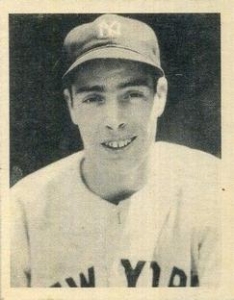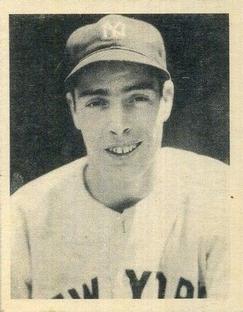August 13, 1939: A’s suffer worst home loss in Yankees beatdown
 After streaking out of the gate early in the season, the New York Yankees had cooled off by the time they arrived at Shibe Park on August 11. They won the first two games of the series against the hapless Athletics, including an 18-4 win the previous day. The Athletics’ 36-69 record was almost a mirror image of the Yankees’ 72-32.
After streaking out of the gate early in the season, the New York Yankees had cooled off by the time they arrived at Shibe Park on August 11. They won the first two games of the series against the hapless Athletics, including an 18-4 win the previous day. The Athletics’ 36-69 record was almost a mirror image of the Yankees’ 72-32.
A crowd of 34,570 came to Shibe Park for the doubleheader on the afternoon of August 13 to see if their Athletics might salvage the series against the mighty Yankees. The gates were closed a few innings into the first game and it was estimated that at least 10,000 fans were turned away.1
The A’s gave the hometown crowd something to cheer about when they won the first game, 12-9. The Athletics scored three runs in bottom of the ninth inning on a walk-off home run by Frankie Hayes to beat the Yankees and break an eight-game losing streak.
Athletics fans were thrilled to see their team finally win a game. It was just the second time they had beaten the Yankees in the 1939 season. They had won on June 26, the last time the Yankees were in town. But the Yankees, in a harbinger of things to come, beat Philadelphia 23-2 the next day.
For the second game of the twin bill, rookie Henry “Cotton” Pippen took the mound for the Athletics. After spending most of the previous seven years in the St. Louis Browns farm system, Pippen had been picked up by the Athletics in the Rule 5 draft the previous fall. Pippen had struggled all season and entered the game with a 2-8 record. Pippen had lost his only start against the Yankees, on May 26 when he pitched a complete game and gave up only one run, the only one the Yankees needed as Oral Hildebrand pitched a shutout.
After Pippen got the Yankees out in order in the first inning, they jumped on him for five runs in the second. Joe DiMaggio singled and ended up on third when Bill Dickey followed with a double. A triple by George Selkirk brought both runners home. Pippen walked the next two batters to load the bases. Pitcher Red Ruffing then singled to bring home two more runners.
After a popup to shortstop got the first out of the inning, Red Rolfe singled in another run. By the time Pippen got the third out, the Athletics were in a 5-0 hole.
In his previous two starts against Philadelphia in 1939, Ruffing had notched two wins behind 18 runs from his teammates. Ruffing walked three batters in the first inning but none of the Athletics reached home. After getting out that jam, Ruffing allowed just three more Athletics hits while striking out five batters.
When Pippen gave up a leadoff single to Dickey in the third, Athletics manager Connie Mack pulled him for Nels Potter. Potter fared no better. After Selkirk singled, an error by third baseman Joe Gantenbein allowed Dickey to score. Ruffing picked up his third RBI of the game when his groundout to the pitcher sent Selkirk home. Potter then walked two batters and surrendered a pair of singles to allow the Yankees to score three more runs. By the time the Athletics got the third out, they were down 10-0.
James Isaminger of the Philadelphia Inquirer wrote that “[t]he Athletics were completely smothered in the (game). The Yankees kept up such a steady drumbeat of base blows [that] Pippen was stormed off the tee in the third and Potter merely threw kerosene on the blaze.”2
The Yankees scored two more runs in the fourth when Babe Dahlgren homered with a runner on base. Even though Potter struggled, Mack kept him in the game. Another run was added to the Yankees’ total in the fifth when Charlie Keller singled and later scored. The Yankees’ lead now was 13 runs. It was the 12th consecutive game in which Keller hit safely.
As Ruffing kept the Athletics in check, his teammates continued to pound away at Potter. Potter walked Dahlgren and gave up a single to Ruffing to start the sixth. With one out, Rolfe doubled to add another run to the Yankees’ total. Two batters later, DiMaggio hit a three-run inside-the-park home run. Potter needed just one more out to get out of the inning but he couldn’t get it. Three more singles brought home the fifth Yankees run of the inning to make the score 18-0.
Potter kept the Yankees from scoring in the seventh but DiMaggio led off the eighth with his second homer, giving him five RBIs for the game. DiMaggio’s blast cleared the roof of the left-field stands; Isaminger called it a “masterpiece.”3 After Tommy Henrich reached first on an error, Dahlgren hit the Yankees’ second inside-the-park home run of the game. The two-run blast gave the Yankees a 21-0 lead.
As the Yankees scored runs in inning after inning, Ruffing kept the Athletics in check. He gave up just three hits to the Mackmen, the final one a triple by Earle Brucker in the sixth. After Ruffing retired the Athletics on three fly balls in the eighth inning, the game was ended because of Philadelphia’s 7 P.M. curfew. It was Ruffing’s 17 th victory of the season. While Ruffing kept the Athletics off the bases, his teammates battered the A’s for 23 hits against Pippen and Potter.
The game was one of five shutouts by Ruffing during his career in which the Yankees scored at least 15 runs. The others were 18-0 (1936), 17-0 (1931), and 15-0 twice (1937 and 1942). Ruffing helped himself in the game by getting four hits and driving in three runs. Ruffing’s own powerful bat produced 36 homers and more RBIs than any other modern pitcher.
The New York Times made an understated note of the victory, saying “[t]here was nothing to the victory. The Yanks were racing against time in a batting workout, for they had to get in five innings before the 7 o’clock deadline4 to make it a game.” The game was called at 6:49 P.M. to conform with Philadelphia’s Sunday baseball law.5
The Yankees’ victory was the most lopsided shutout since the Detroit Tigers beat the Cleveland Indians 21-0 in 1901. That game was also shortened, because the Indians had to catch a train to Boston.6
SOURCES
In addition to the sources cited in the Notes, the author used Baseball-Reference.com and Retrosheet.org for box-score, player, team, and season information as well as pitching and batting game logs, and other pertinent material.
baseball-reference.com/boxes/PHA/PHA193908132.shtml
retrosheet.org/boxesetc/1939/B08132PHA1939.htm
NOTES
1 James Isaminger, “Hayes Ninth Inning Homer Wins Opener,” Philadelphia Inquirer, August 14, 1939: 17.
2 Isaminger: 18.
3 Isaminger: 17
4 James Dawson, “Athletics Routed With 23 Hits, 21-0,” New York Times, August 14, 1939.
5 At the time, Philadelphia’s Blue Laws limited what commercial enterprises could take place on Sundays. Sunday baseball began in Philadelphia in 1934 after protracted court battles.
6 Ronald Liebman, “The Most Lopsided Shutouts,” Baseball Research Journal 5 (1976).
Additional Stats
New York Yankees 21
Philadelphia Athletics 0
8 innings
Game 2, DH
Shibe Park
Philadelphia, PA
Box Score + PBP:
Corrections? Additions?
If you can help us improve this game story, contact us.


